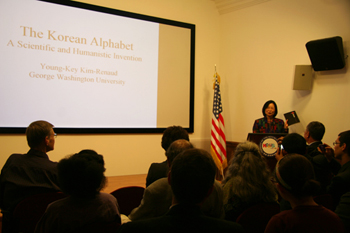 The Korean writing system, known as Hangeul, is unique among languages: not only does humanity have a comprehensive record of its design and creation in the 15th century, but the specific reasons for it as well.
The Korean writing system, known as Hangeul, is unique among languages: not only does humanity have a comprehensive record of its design and creation in the 15th century, but the specific reasons for it as well.
“[King Sejong] was an exemplary Confucian ruler with a true concern for his subjects,” explained Young-Key Kim-Renaud, professor of Korean language and culture studies at the
The name “Hangeul” was in fact not used until the early 20th century, Kim-Renaud explained; prior to that, it was known as Hunminjeongeum (훈민정음), whose translation helps explain its creator’s intentions.
The four syllables of “Hunminjeongeum,” in translation, roughly mean: to teach, or discipline, the populace in the authentic sounds of language.
“Already, you are struck by the syllable meaning ‘the sound,’” Kim-Renaud said. “So, it’s a phonetic system compared to all the others Koreans were using before Hangeul, [such as Chinese characters].”
Not only is the Korean script highly phonetic, meaning that each letter represents one specific sound (compare that with English, where the same vowel letters in the words “moon,” “blood,” and “good” are each pronounced differently), but some Hangeul “letters” also uses visual approximations of their formation in the human mouth to represent sounds.
The original Hunminjeongeum document, now recognized by the United Nations as a world cultural heritage item, also contained a preface that justifies the project and elucidates the social situation in 15th century
As translated by Kim-Renuad, “The sounds of our country’s language are different from those of the Middle Kingdom (
“Commiserating with this, I have newly designed 28 letters. I desire only that everyone acquire them easily to make them convenient and comfortable for daily use.”
The underlying idea, Kim-Renaud said, was that the ability to write is a basic human right, and should not merely be a luxury enjoyed by the upper classes alone.
“His notion of literacy is not very different from today’s,” she added.
Being phonetic and sound-based, rather than symbol-based, meant Hangeul was easy to learn. Although the original document was written in classical Chinese, Korean official documents were being written in Hangeul within 13 years. In the decades that followed, public literacy increased dramatically. Today, more than 90 million people speak Korean and use Hangeul to communicate in all forms of media.
By Adam Wojciechowicz